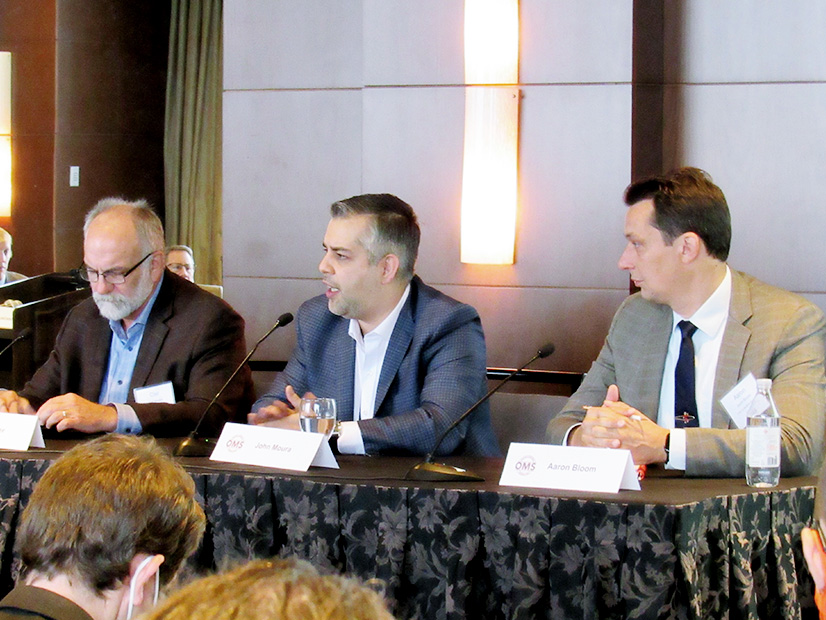MINNEAPOLIS — The Organization of MISO States emphasized the footprint’s deteriorating resource adequacy during its annual meeting, with President Marcus Hawkins saying MISO’s increasing maximum generation warnings and emergencies can’t be ignored.
“We had almost no max gen events before 2016,” Hawkins said during Thursday’s meeting. “I think we had one in the decade before 2016, and now I’ve lost track. It used to be 20 and now it’s 30 or 40.”
“It used to be really simple. You count up all the capacity, you build a reserve margin — about 15% — and you call it a day,” John Moura, NERC’s director of reliability assessment and system analysis, said during one panel.
Now, he said, intermittent resources have necessitated distinct needs for voltage, frequency response and fuel backups.
“It’s not the same as it is before,” Moura said, adding that there’s no longer a “two-month, three-month” stash of coal sitting outside of generators.
“I can’t give the thumbs up, the thumbs down, the thumbs sideways about simply a reserve margin,” he said.
Moura also acknowledged that grid operators face loss-of-load risks outside of the summer months and must take action. “I worry that the stakeholder processes are a little slow and might take just small bites out of the apple instead of a big chomp,” he said.
“The fleet is changing faster than the academic treatment of the risk,” MISO President Clair Moeller said. He said stakeholders’ agreement on resource adequacy measures is only second in difficulty to reaching consensus on cost-allocation issues.
Moeller said coal generation’s share of the resource fleet has dropped from 70% to 37% share in the span of a few years. He said the risks posed by baseload generation retirements are worsened by more common extreme weather events. Regional transmission operators must do a better job of factoring weather risks into resource planning, he added.
“Winter Storm Uri was an unmitigated disaster,” Moeller said. “The poorest among us don’t have any resources to respond to that kind of catastrophe. They deserve our best efforts … People and their livelihoods are depending on us, so we need to bring our A-game.”
Moeller said MISO may need some temporary “scaffolding” to prop up existing resources until they can safely retire as the footprint undergoes decarbonization.
“There might have to be — and don’t throw me out of the room here — some price support for coal. At least until we can get to the future,” he said. “Losing 53 MW of coal before its time blows a fair-sized hole into the resource stack. …The transition period is a risky period. We’re maybe too focused on the endpoint versus how to get there safely.”
Moeller said the RTO’s most aggressive electrification estimates for the next 20 years indicate the footprint will need to add more than $400 billion in new generation and about $100 billion in new transmission to handle fresh demand and new flow patterns. Moeller said he suspected MISO will need some new ratemaking rules to recover fixed costs for new infrastructure.
 Outgoing OMS President Julie Fedorchak addresses attendees. | © RTO Insider LLC
Outgoing OMS President Julie Fedorchak addresses attendees. | © RTO Insider LLC“I think we need to be careful in promising low costs when talking about this transition. It’s a risky proposition,” North Dakota commissioner Julie Fedorchak added. She said she is “salty” over the enduring assumption that natural gas could provide a low-cost reliability bulwark during the transition; prices have recently doubled. She said when the natural gas building frenzy began, all forecasts pointed to $2-$3/MMBtu natural gas “for the next 20-40 years.”
In a less-than-comforting fireside chat for attendees, FERC Commissioner James Danly said that resource insecurity is an “actuarial” reality.
“The cold, grim reality of the markets not ensuring reliability is not going to play out pleasantly,” he said.
Danly said dispatchable generation needs to be compensated and markets need to make sure they aren’t “lopsided against” the most dependable resources.
Arcadia Power’s Max Minzner reminded attendees that any prolonged generation outages have historically given FERC more authority over electric grid reliability. He pointed to the 2003 blackout as an example.
“The closer we get to having a problem, the closer we get to federal action,” he warned.
Aaron Bloom, with nonprofit Energy Systems Integration Group, said MISO should put emphasis on linking generation in the interconnection queue to the system as quickly as possible.
MISO Makes Case for Regional Resource Assessment
Richard Doying, MISO’s executive vice president of markets, reserved meeting time to boost support for the RTO’s first regional resource assessment, due out next month.
 MISO’s Richard Doying | © RTO Insider LLC
MISO’s Richard Doying | © RTO Insider LLCStakeholders have pushed back on the need, saying information contained in the report could be misused in state dockets to challenge utilities’ integrated resource plans. (See LSEs, Southern Regulators Pan MISO Resource Assessment.)
“We have to ask that question, will the pool five years out, 10 years out, 20 years out be able to provide the services, flexibility, availability of resources to reliably serve load,” Doying said.
He said MISO is currently projecting a capacity shortfall, but he said he is not “unduly” worried. Doying said not all of the footprint’s resource additions have been announced and the RTO’s utilities are “prudent planners.”
Doying said MISO has a duty to publicly share its resource-planning expectations. “There is a paucity of public information out there.”
Doying said MISO will not suggest what utilities and regulators should do with MISO’s regional insights.
“It’s not to recommend anything, but hopefully it makes you ask some questions,” Doying told OMS members.
He said the pace of change in the portfolios that members have laid out so far is head-spinning.
“The announcements for renewables seem to change weekly, it seems, every time we put together a spreadsheet,” Doying said. “The goals are constantly changing.”
The Novelty of Face-to-Face Interaction
Despite the sobering topics, the annual meeting marked the first in-person event in two years for many stakeholders. Several panelists remarked how refreshing it was to speak face-to-face.
Outgoing OMS President Fedorchak thanked the organization for being among the first to venture back into in-person meetings. She said the pandemic has given many a renewed appreciation for in-room discussions.
Hawkins said the meeting was “conveniently recycled” from its scrapped 2020 plans.
OMS members elected Indiana Utility Regulatory Commissioner Sarah Freeman as their 2022 president. Michigan regulator Dan Scripps will step in as vice president.




